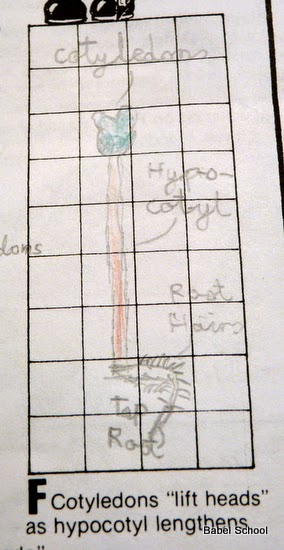DAY 3 - WEDNESDAY
 |
| The radishes in the box started to show leaves! |
 |
| You can also see the tap root. |
 |
| Drawing the 5th stage of sprout growth. |
 |
| Stages 4 and 5. |
 |
| The bar graph showing how many sprouts are at each stage. |
Starting new experiment - FOUR ENVIRONMENTS
We are observing how the seeds sprout in four different environments:
- dry - no water at all (seeds on the lid)
- very wet - seeds submerged in water (inside the water filled jar)
- wet with plenty of oxygen - seeds on a wet paper towel
- wet with little oxygen - seeds on a wet paper towel covered with plastic foil
DAY 4 - THURSDAY
 |
| Growing taller. |
 |
| Now most of the sprouts are in stage F (6) and almost the same number of sprouts are in stage D (4) and E (5). |
Starting new experiment - NIGHT AND DAY
Let's observe how the seeds sprout in complete darkness and how under sunlight.
 |
| One jar will be completelt dark and the other will have plenty of light. |
 |
| After placing the seeds is both jars we covered them with lids. |
DAY 5 - FRIDAY
 |
| That's as tall as the sprouts are going to get in our box. Today we planted some of them in soil (see below). |
 | ||
| As you can see most of the sprouts are in the F (6) stage of growth. |
Starting new experiment - LIVING SPACE
How much space do plants need to grow large and strong? Do they prefere to be cramped together or do they need more space? Let's find out!
We took some sprouts out of our box and after trimming a bit tap roots (some were too long), we replanted them. We put 2 in one planter and 12 in the other. Now we have to wait and see how they grow.
To read previous post about how we started growing radishes, please go to part 1.










Comments
Post a Comment